Contents
Market Overview
Macro Review
FOMC minutes offered a hawkish tilt. Fed and Eurodollar futures both rose as the probability of a March hike is now greater than 70%, with balance sheet reduction expected after rate lift-off. Fedspeak from Daly and Kashkari was more telling as the last remaining doves are beginning to give-way. That said, the move in U.S. Treasuries began in earnest on Monday, with significant outflows in retail ETFs. The second bout of volatility was triggered by FOMC minutes, which shifted into a higher gear as Kashkari stated that he now expects two hikes in 2022 (the dots are still at three), and Daly offered another meaningful departure from previously held views. The hawkish rhetoric remains consistent across EM too. Peru hiked 50 bps, Argentina raised rates by 200 bps and Mexico’s Central Bank minutes read as hawkish, just as inflation in Chile, Colombia and Poland rose to multi-year highs. Within Central and Eastern Europe, unrest in Kazakhstan dominated. A state of emergency was quickly followed by CSTO coalition forces assisting the Kazakh military to restore calm. Despite the concerning headlines, the sovereign bond curve is only 3 bps wider of where it started the week, as cash prices on long-dated bonds suffered more on U.S. Treasury volatility than political noise. Meanwhile, Evergrande’s stock was briefly suspended, Shimao was said to have defaulted on an onshore trust but the company refuted this allegation, Guangzhou R&F reported that it did not have as much cash as it previously thought in December and Tencent remained under pressure after divesting a subsidiary in Singapore. Then just as China reported upbeat PMIs, it’s second city went into lockdown, shortly followed by Hong Kong tightening restrictions.
EM Credit Update
Emerging market sovereign credit began 2022 by falling 1.4% this week, as U.S. Treasuries widened 20-28 bps. The sovereign investment grade component was down some 1.9%, with credit spreads 1 bp wider. EM corporate credit fared far better, with returns of -0.5% this week, partially helped with credit spreads tightening 9 bps. Tunisia, Ecuador and Belarus outperformed, while Argentina, Ghana and Sri Lanka lagged.
The Week Ahead
Next week the geopolitical focus will be consumed by U.S. and Russia negotiations as the “three track talks” commence. Then Fed re-nomination events with Chair Powell and Governor Brainard will create more than a headline or two, before U.S. bank earnings kick-off. Meanwhile, credit data out of China, along with CPI and trade data, will be closely watched, and any pullback in inflation will offer some leeway to increase policy support ahead of the Lunar New Year. Interest rate decisions are due from Hungary (4.0%), Korea (1.0%) and Romania (1.75%). Thereafter, inflation releases from Argentina, Brazil, Czech Republic, Romania, Hungary, India and Israel are due. Inflation out of CEE will follow the Eurozone CPI reading last Friday which accelerated beyond record levels to 5.0%, faster than the previous record high last month of 4.9%. However, above all, the most closely watched inflation release will be U.S. CPI on Wednesday.
Highlights from emerging markets discussed below include: Kazakh authorities appear to have regained control amid recent unrest, but questions around the medium-term political transition from the Nazarbayev regime have resurfaced and Minister Guzman presented Argentina’s roadmap for IMF negotiations to governors in aim to consolidate political support.
Fixed Income
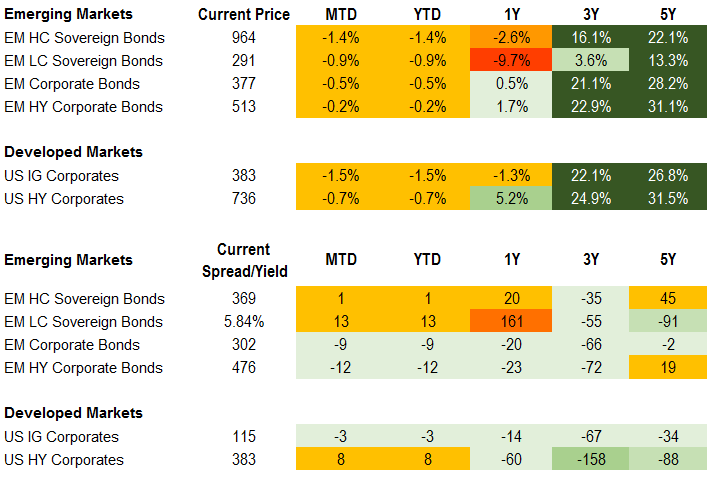
Equities
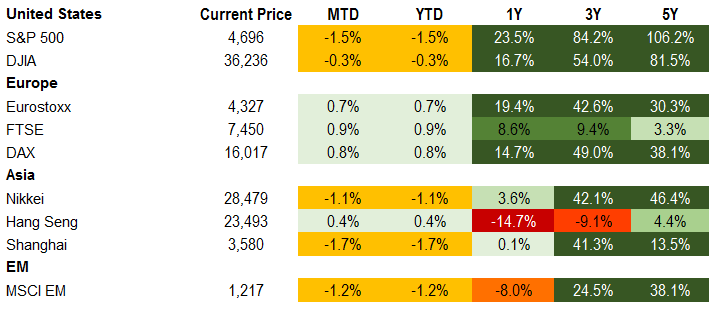
Commodities

Source for data tables: Bloomberg, JPMorgan, Gramercy. EM Fixed Income is represented by the following JPMorgan Indicies: EMBI Global, GBI-EM Global Diversified, CEMBI Broad Diversified and CEMBI Broad High Yield. DM Fixed Income is represented by the JPMorgan JULI Total Return Index and Domestic High Yield Index. Fixed Income, Equity and Commodity data is as of January 7, 2022 (mid-afternoon).
Emerging Markets Weekly Highlights
Kazakh authorities appear to have regained control amid recent unrest, but questions around the medium-term political transition from the Nazarbayev regime have resurfaced
Event: Kazakhstan, the world’s largest landlocked country and significant oil/gas producer, experienced a sudden wave of social unrest this week, ostensibly sparked by sharp fuel price increases in some regions. The outburst of social discontent quickly spread across the country, triggering political/economic concessions by the authorities and resignation of the government. However, such “carrots” offered to the protesters were combined with “sticks” in the form of a significant crackdown in the streets after protests swelled and turned violent, including in Almaty, Kazakhstan’s largest city.
Gramercy Commentary: As of the time of writing, it appears that the Kazakh authorities have regained control of the situation with heavy military presence in the streets. Kasym-Zhomart Tokaev, Kazakhstan’s President, has labeled the strong security response an “anti-terrorist operation” and requested a peacekeeping mission from the Collective Security Treaty Organization (CSTO), a Russia-led regional security pact that has sent troops to support the Kazakh military with guarding key infrastructure. The Biden Administration has also expressed full support of Kazakhstan’s “constitutional institutions”. As such, near-term risks of escalating social conflict and/or political chaos have been reduced sharply. In addition to its ability to quell protest by repressive actions, the Kazakh government has sizable resources at its disposal to increase fiscal spending that could be financed by borrowing or transfers from the $55bn sovereign wealth fund. Also, U.S. diplomatic support voiced by Secretary Blinken means that economic sanctions from Washington as a result of the ongoing crackdown against protesters are highly unlikely. Against this backdrop, the initial negative market reaction on Kazakh and Russian assets, albeit quite limited to begin with, is likely to correct further. However, we expect some level of additional political risk premium to remain priced in Kazakhstan’s credit markets as the abrupt and wide-spread unrest has highlighted vulnerabilities in the country’s existing economic and political framework, a reflection of former President and honorary “leader of the nation” Nursultan Nazarbayev’s continuing dominance over political, economic, and social life. As such, a continuation of the controlled and peaceful power transition away from Nazarbayev and his inner circle that started in 2019 is the key factor that will drive Kazakhstan’s investment story over the medium-term. Last but not least, Kazakhstan is a strategically important country in central Asia, being a key Russian ally that has been able to maintain good relations with the West and China. In that context, recent developments in Kazakhstan might have geopolitical implications beyond the region and could carry relevance in upcoming high-level talks between the U.S. and Russia over broader global security issues.
Minister Guzman presented Argentina’s roadmap for IMF negotiations to governors in aim to consolidate political support
Event: This week, the Economy Minister, Martin Guzman, with President Alberto Fernandez and 19 out of 24 governors delivered a qualitative plan and terms for an eventual IMF agreement. The presentation focused on three main areas: fiscal policy, FX reserves, and BCRA transfers to Treasury. Guzman conveyed alignment between the government and the IMF on the latter two issues with discrepancies persisting over fiscal adjustment. This follows the government’s $1.8bn payment to the Fund and the IMF’s publication of its ex-post review of Argentina’s exceptional access under the 2018 SBA just ahead of the holidays. The report critiqued limitations of the program assumptions, political ownership as well as risk analysis and communication. The authorities’ response to the assessment was focused largely on policy elements of the program which they deemed poorly fit for the Argentine economy.
Gramercy Commentary: We see Guzman’s presentation as one piece of the broader domestic political puzzle required for an eventual agreement, but similar to the bond negotiations, the prolonged and theatrical approach increases uncertainty regarding the timeline for a deal. While members of the opposition boycotted the event and rightly critiqued the plan for lack of detail, we do not think this precludes the government from eventually obtaining enough domestic political buy-in to strike a resolution with the Fund. With a primary fiscal deficit likely between 3-3.5% of GDP for 2021, the political and economic effort required for the government to improve its position to 2.5-3.0% should be feasible. Lack of detail on how to reach the FX reserve accumulation target suggests that structural policies to boost FDI and inflows may not receive immediate pushback from the government but rather face low likelihood of implementation or success once a program is in place. In the coming weeks and months, we expect markets to continue to focus on the domestic political maneuvering regarding a deal, FX reserves amid an uncertain harvest and external environment, BCS rate as supportive seasonal factors roll-off and fiscal performance as the government operates via decree absent an official 2022 budget.
Emerging Markets Technicals
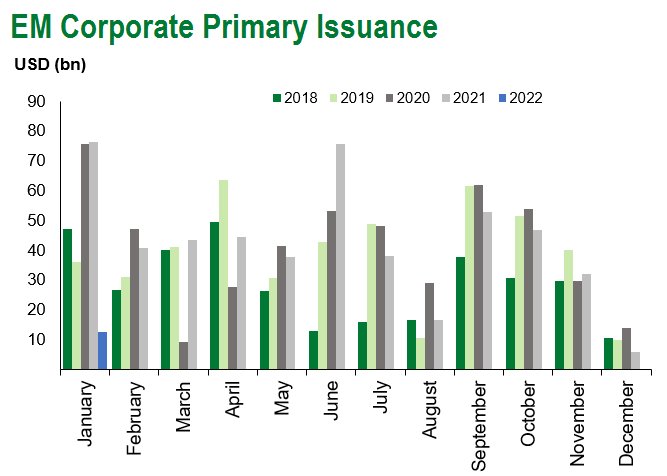
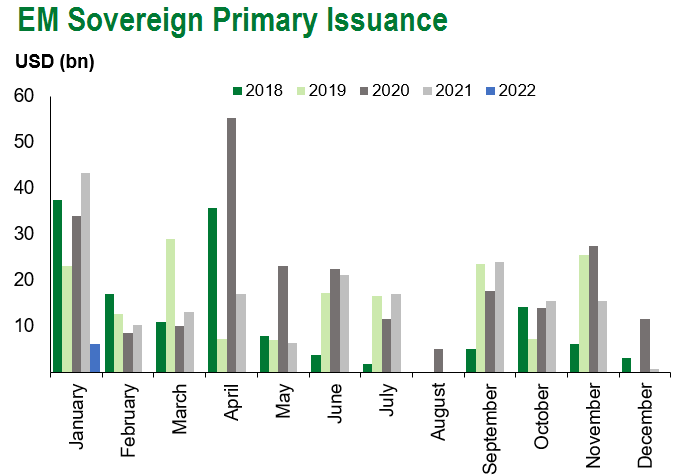
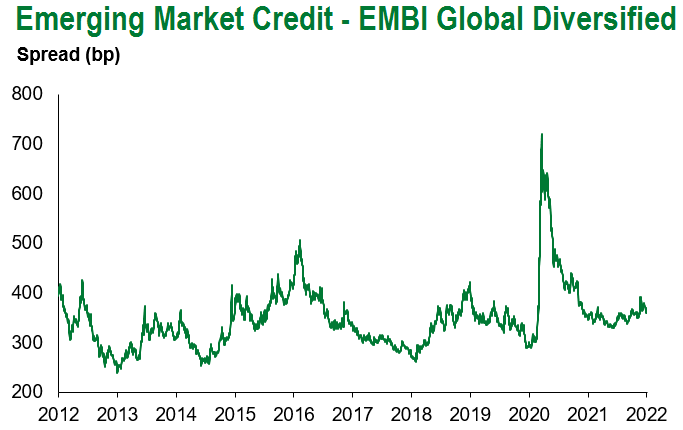

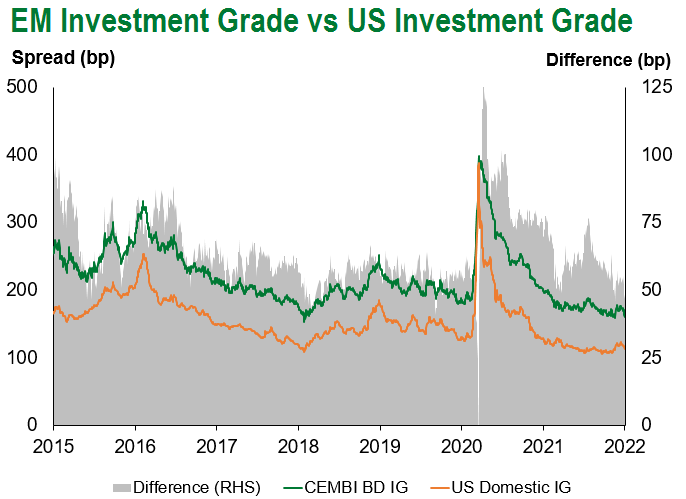
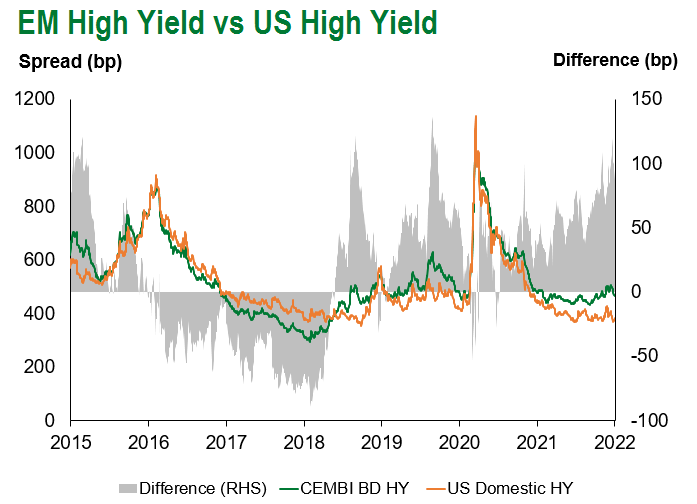
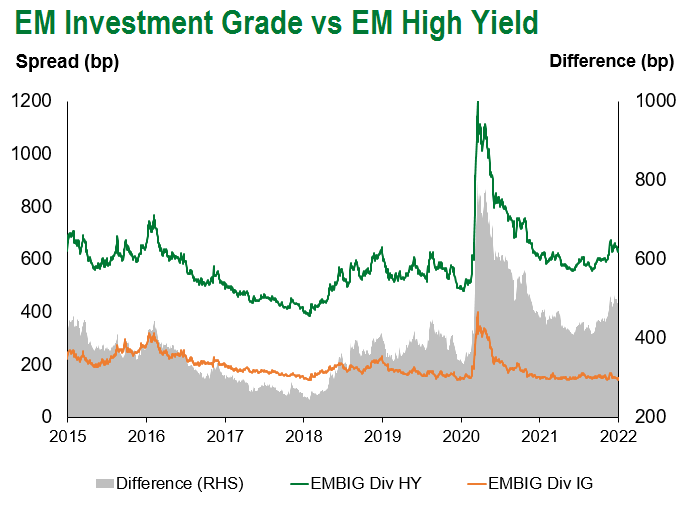
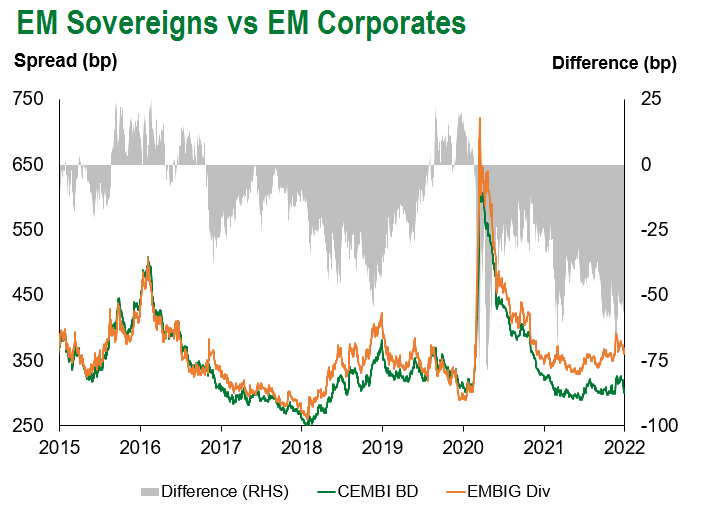
Emerging Markets Flows
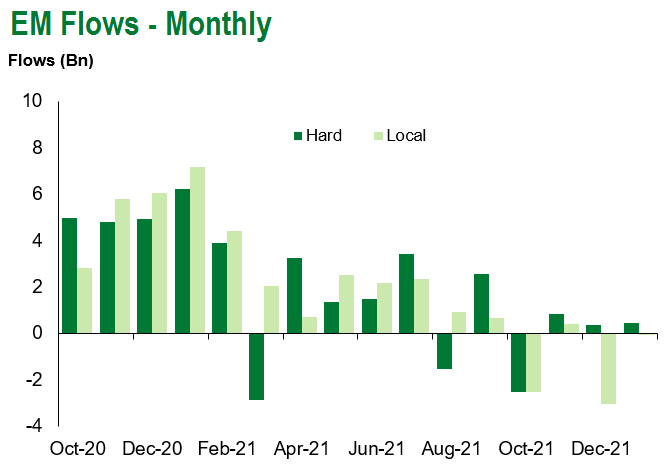
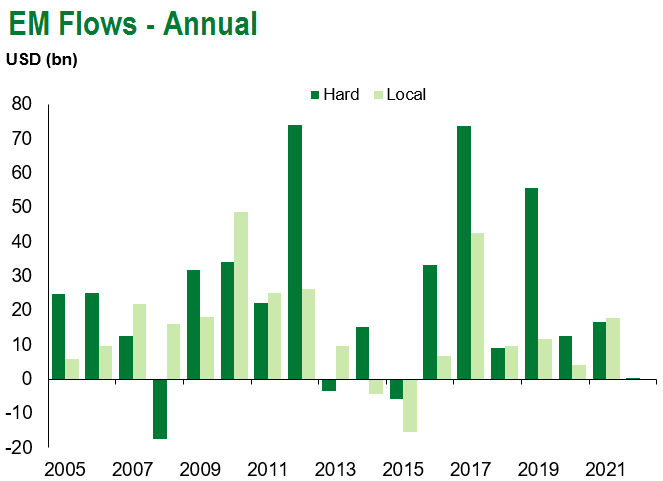
Source for graphs: Bloomberg, JPMorgan, Gramercy. As of January 7, 2022.
COVID Resources
Emerging Markets COVID-19 Case Summary
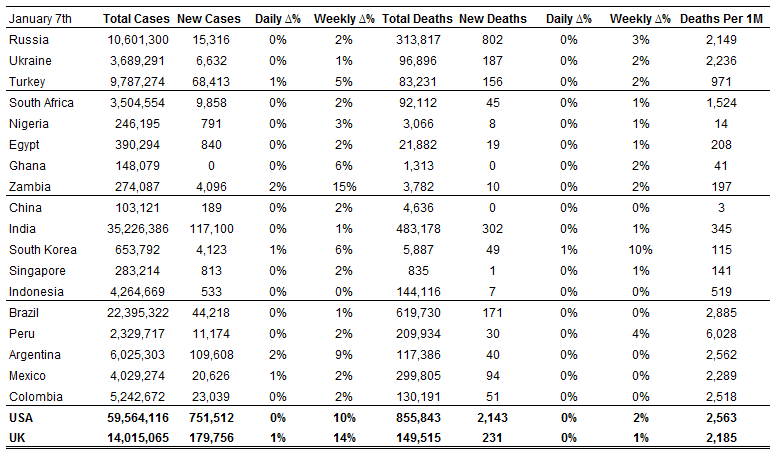
Source: Worldometer as of January 7, 2022.
Additional Crisis Resources:
Johns Hopkins COVID-19 Case Tracker
For questions, please contact:
Kathryn Exum, CFA ESG, Senior Vice President, Sovereign Research Analyst, [email protected]
Petar Atanasov, Senior Vice President, Sovereign Research Analyst, [email protected]
Tolu Alamutu, CFA, Senior Vice President, Corporate Research Analyst, [email protected]
James Barry, Vice President, Corporate Research Analyst, [email protected]
This document is for informational purposes only. The information presented is not intended to be relied upon as a forecast, research or investment advice, and is not a recommendation, offer or solicitation to buy or sell any securities or to adopt any investment strategy. Gramercy may have current investment positions in the securities or sovereigns mentioned above. The information and opinions contained in this paper are as of the date of initial publication, derived from proprietary and nonproprietary sources deemed by Gramercy to be reliable, are not necessarily all-inclusive and are not guaranteed as to accuracy. This paper may contain “forward-looking” information that is not purely historical in nature. Such information may include, among other things, projections and forecasts. There is no guarantee that any forecasts made will come to pass. Reliance upon information in this paper is at the sole discretion of the reader. You should not rely on this presentation as the basis upon which to make an investment decision. Investment involves risk. There can be no assurance that investment objectives will be achieved. Investors must be prepared to bear the risk of a total loss of their investment. These risks are often heightened for investments in emerging/developing markets or smaller capital markets. International investing involves risks, including risks related to foreign currency, limited liquidity, less government regulation, and the possibility of substantial volatility due to adverse political, economic or other developments. The information provided herein is neither tax nor legal advice. Investors should speak to their tax professional for specific information regarding their tax situation.